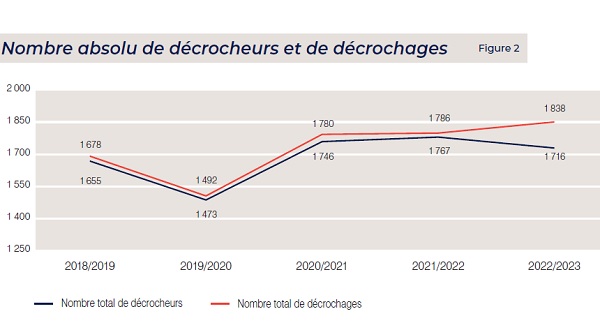 Credit: MENEJ
Credit: MENEJ
Luxembourg's Ministry of Education, Children and Youth has published the new edition of a report on school dropouts and young inactive people in the Grand Duchy, focusing on the years 2018/2019 and 2022/2023.
After a rebound in 2020/2021 (COVID-19 years), the 2022/2023 rate decreased by 0.5 percentage points compared to 2021/2022. In 2021/2022, the dropout rate was 8.1% (1,767 students); in 2022/2023, it decreased to 7.6% (1,716 students).
According to the ministry, the fight against school dropouts is one of its priorities. The ministry described the decline in dropout rates for the second consecutive year as "encouraging news which reflects the efforts undertaken in the field of national education and the care of at-risk students". For these efforts to succeed, the ministry said it was important to clearly understand the phenomenon, to identify the groups of students most affected and to understand the reasons that lead a young person to leave school prematurely.
Dropout rates:
- 2018/2019: 7.8%
- 2019/2020: 7.0%
- 2020/2021: 8.2%
- 2021/2022: 8.1%
- 2022/2023: 7.6%
The ministry noted that Luxembourg has achieved the objective set by the European Union as part of its strategy of reducing dropout rates below the threshold of 9% until 2030.
The ministry also explained how its services in charge of monitoring dropouts encourage young people to return to school and benefit from flexible registration deadlines, beyond the start of the school year.
Excluding dropout students who re-enrolled the following school year, the rate of effective dropouts in 2022/2023 was 5.8%, thus reaching a level comparable to the year 2019/2020 (when the rate was lower than usual, at 5.7%). This rate stood at 6.7% in 2021/2022.
The ministry noted that certain groups of students are at greater risk of dropping out, namely:
- students who have fallen behind in school by at least two years: this is the case for 69.8% of dropouts;
- boys more than girls: boys represent a little more than 60% of dropouts each year;
- secondary students in 4e and 5e classes (representing 48.5% of dropouts in 2022/2023). These classes constitute pivotal moments in the choice of training path or orientation of studies.
The ministry explained that the development of socio-professional integration centres (CISP) was one of its key avenues to respond to the distress of young people (at risk of) dropping out of the school system. The offer is aimed at young people in two age groups; students aged twelve to sixteen, who are enrolled in specialised "RELANCE" classes, and accomplished students or young dropouts aged sixteen to 24, who are enrolled in classes with special objectives called "RECONNECT" classes.
The objective of these classes is the reconciliation of young people with the school system and the continuation of their educational or professional training path. An expansion of the offer is planned in the coming years as well as scientific support at the national level.
Moreover, the local branches of the National Youth Service (SNJ) carry out individual monitoring of dropouts, to the extent that they are able to contact them. In 2022/2023, they contacted and offered their support to 2,021 young people.
The ministry added that the SNJ mainly offers alternatives to inactivity, such as voluntary services, workshops and discovery courses. Voluntary services are becoming increasingly popular and well attended among young people (+8.7% in 2022/2023 compared to the previous year). The highest participation occurred during the months of February to June.
The number of young people participating in a workshop or discovery course also increased compared to 2021/2022. Internships were particularly successful with young people wanting to move towards an apprenticeship (+31.3% compared to 2021/2022).








